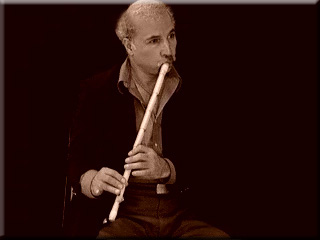The nây (Farsi
for 'reed') is an open-ended, obliquely blown flute known in the Near East since
antiquity. It is made out of reed, and played with the pads of the fingers. It has six
fingerholes and a thumbhole, and a wide range of over two octaves. Nây-s come in
different lengths, each one being tuned to a specific pitch and named after the note
produced with the 1st fingerhole open (D4 for the nây used in the demonstration. Lowest note: C4).
It is blown using a unique lip technique called bilabial blowing,
with both upper and lower lip used to partially close the end of the bevelled tube. The
2nd and 3rd registers are overblown a fifth and an octave higher than the 1st register
respectively. Some of the tone-holes are assigned to certain microtonal steps, although
microtonal variations can also be achieved by partially opening a tone-hole, changing the
blowing angle, or a combination of the two.
Although the nây carries some pastoral associations, it is
considered an urban instrument. It is the only wind instrument used in Arab art music,
widely appreciated for its warm, breathy sound and its subtle tonal and dynamic
inflections. |

Video demonstration on the nây by Ali Jihad Racy |
